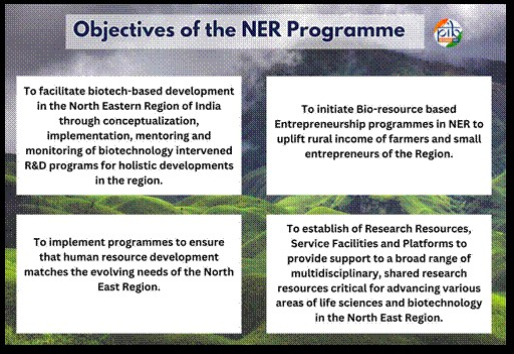22 February 2025: PIB Summary For UPSC
1. How Biotechnology is Transforming North East India
(Source – https://pib.gov.in/PressReleasePage.aspx?PRID=2105241 )
| Context |
| India’s North East Region is leveraging biotechnology for sustainable growth through research, education, and entrepreneurship. |
Introduction
- India’s North East Region (NER) is rich in biodiversity, culture, and natural resources.
- Biotechnology is playing a key role in preserving this heritage while promoting growth and sustainability.
- The Department of Biotechnology (DBT) has been supporting various initiatives to harness bioresources, improve education, and create job opportunities.
Funding and Major Initiatives
- Since 2010, DBT has allocated 10% of its annual budget to specialized programs in NER.
- These programs focus on research, education, and employment in biotechnology.
Key Programs Under the North Eastern Programme

Twinning R&D Programme for NER
- Launched in 2010-11 to build biotechnology capacity in NER.
- Collaborations between 65+ institutions have supported nearly 650 R&D projects.
- Benefitted around 450 researchers and 2,000 students.
Biotech Hubs
- Since 2011, 126 Biotech Hubs have been established in universities, colleges, and institutions.
- These hubs provide infrastructure and training to support biotechnology education and research.
Biotechnology Labs in Senior Secondary Schools (BLiSS)
- Initiated in 2014 to provide students with well-equipped biology laboratories.
- Aims to create awareness and interest in biological sciences at the school level.
Visiting Research Professorship (VRP) Programme
- Started in 2015 to bring expert scientists to institutions in NER.
- Focuses on advancements in biotechnology and life sciences.
Specialized Training for NE Researchers
- Chemical Ecology Programme (2015): Trained young scientists from NER in chemical ecology through collaboration with Bangalore institutions.
- Genomics-Driven Research (2016): Focused on training scientists, researchers, and clinicians in biomedical research and molecular genetics.
Human Resource Development (HRD) in NER
- Programs emphasize services for farmers and academics.
- DBT-North East Centre for Agricultural Biotechnology (DBT-NECAB): Phase III focuses on agricultural advancements.
- Citrus Research Facilities: Established in Assam to develop disease-free citrus varieties.
Support for Farmers and Entrepreneurs
- 64.1 acres dedicated to cultivating medicinal crops like Curcuma caesia and lemongrass.
- 649 farmers and entrepreneurs have received training and awareness.
- An essential oil distillation unit set up in Arunachal Pradesh to help farmers generate income.
- Docynia indica (Assam apple) Value Addition: Farmers and tribal communities trained to make products like pickles, jam, and juice.
Major Achievements
Development of Bacterial Blight-Resistant Rice
- A new rice variety named “Patkai” was developed in Assam.
- It is resistant to bacterial blight and has been approved by the Central Variety Release Committee (CVRC).
Rapid Disease Detection for Livestock
- A lateral flow assay was developed for detecting brucellosis in livestock.
- The test provides quick and accurate results based on serum samples.
Mobile Application for Pig Disease Diagnosis
- Pig Disease Diagnosis Expert System (PDDES) was developed to assist in diagnosing pig diseases.
- The app is available on the Google Play Store and helps veterinarians and farmers manage livestock health.
Conclusion
- Biotechnology initiatives in NER are helping preserve biodiversity, boost education, and promote entrepreneurship.
- By integrating science with traditional knowledge, the region is advancing toward sustainable economic growth.
| Practice Question: How has biotechnology contributed to sustainable development in India’s North East Region (NER), and what are the key initiatives driving this transformation? (150 Words /10 marks) |




